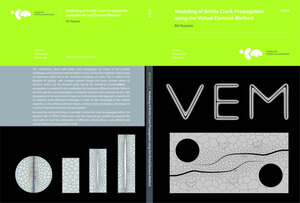
×
![Buchcover ISBN 9783941302365]()
Modeling of Brittle Crack-Propagation using the Virtual Element Method
von Ali Hussein, herausgegeben von Peter WriggersComputational Mechanics has many applications in engineering. Its range of application has been enlarged widely in the last decades. Still new developments are made to which a new discretization scheme belongs: the virtual element method (VEM). Despite being only few years under development, the application range of VEM in engineering includes formulations for linear and nonlinear material responses. In this work the focus is on fracture mechanics. Especially the treatment of crack propagation will be discussed where VEM has some advantages. VEM allows exploration of features such as the flexibility in dealing with complex element shapes and nodes number within an element which can be changed or added easily during the computation. Thus, such a method seems to be extremely useful for simulation of crack propagation problems.
As a first step, we have developed a two-dimensional virtual element model for elastic solids undergoing small strains. The formulation of the method is tested by means of well known examples: the patch test and the infinite plate with a circular hole. In order to take advantage of the method regarding to the arbitrary element shapes, a robust cutting technique is developed to construct the crack path during the propagation.
In the first part of this work, the direction of growth is obtained based on the maximum circumferential stress criterion (MCSC) which is a function of the stress intensity factors (SIFs). Hereby, the so called I-integral is implemented to calculate the individual stress intensity factor for each fracture mode, separately.
In the second part, the treatment of crack propagation is based on the phase-field method. In this regard, the two dimensional virtual element code is coupled with the phase-field approach to model brittle fractures in isotropic elastic solids. Furthermore, an adaptive refinement strategy is developed to obtain an accurate solution for the crack path. Finally, the crack is introduced geometrically by using the robust cutting techniques. The advantages of this model can be summarized as (i) refinement is performed without a prior knowledge of the crack growth direction, (ii) hanging nodes are easily treated without any additional constraints, (iii) replacing the refined zone by a discrete crack leads to decreasing the computational time of the simulation.
To demonstrate the performance of the presented model, several numerical examples are provided. The results of the examined examples are in a good agreement with the numerical and experimental data from the literature. Finally, the last chapter gives a summary and some concluding remarks. The limitation and further extensions of this work are suggested.
As a first step, we have developed a two-dimensional virtual element model for elastic solids undergoing small strains. The formulation of the method is tested by means of well known examples: the patch test and the infinite plate with a circular hole. In order to take advantage of the method regarding to the arbitrary element shapes, a robust cutting technique is developed to construct the crack path during the propagation.
In the first part of this work, the direction of growth is obtained based on the maximum circumferential stress criterion (MCSC) which is a function of the stress intensity factors (SIFs). Hereby, the so called I-integral is implemented to calculate the individual stress intensity factor for each fracture mode, separately.
In the second part, the treatment of crack propagation is based on the phase-field method. In this regard, the two dimensional virtual element code is coupled with the phase-field approach to model brittle fractures in isotropic elastic solids. Furthermore, an adaptive refinement strategy is developed to obtain an accurate solution for the crack path. Finally, the crack is introduced geometrically by using the robust cutting techniques. The advantages of this model can be summarized as (i) refinement is performed without a prior knowledge of the crack growth direction, (ii) hanging nodes are easily treated without any additional constraints, (iii) replacing the refined zone by a discrete crack leads to decreasing the computational time of the simulation.
To demonstrate the performance of the presented model, several numerical examples are provided. The results of the examined examples are in a good agreement with the numerical and experimental data from the literature. Finally, the last chapter gives a summary and some concluding remarks. The limitation and further extensions of this work are suggested.


